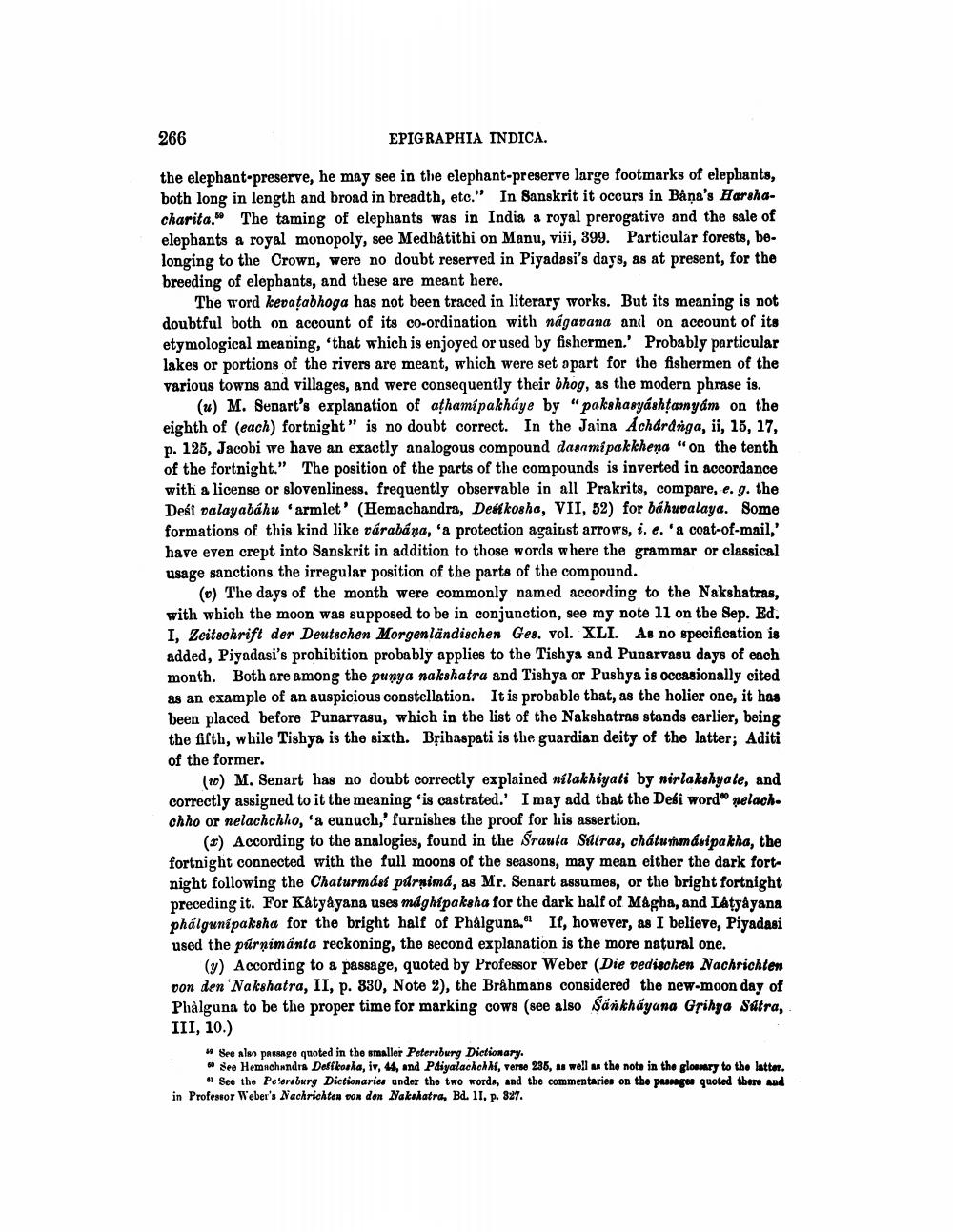________________
266
EPIGRAPHIA INDICA.
the elephant-preserve, he may see in the elephant-preserve large footmarks of elephants, both long in length and broad in breadth, etc." In Sanskrit it occurs in Båna's Harshacharita. The taming of elephants was in India a royal prerogative and the sale of elephants a royal monopoly, see Medhâtithi on Manu, viji, 399. Particular forests, belonging to the Crown, were no doubt reserved in Piyadasi's days, as at present, for the breeding of elephants, and these are meant here.
The word kedatabhoga has not been traced in literary works. But its meaning is not doubtful both on account of its co-ordination with nagarana anil on account of its etymological meaning, that which is enjoyed or used by fishermen.' Probably particular lakes or portions of the rivers are meant, which were set apart for the fishermen of the various towns and villages, and were consequently their bhog, as the modern phrase is.
(u) M. Separt's explanation of athamipakháye by "pakshasyáshtanyám on the eighth of (each) fortnight" is no doubt correct. In the Jaina Achardnga, ii, 15, 17, p. 125, Jacobi we have an exactly analogous compound dasnmipakkhena "on the tenth of the fortnight." The position of the parts of the compounds is inverted in accordance with a license or slovenliness, frequently observable in all Prakrits, compare, e.g. the Desi valayabáhu 'armlet' (Hemachandra, Deákosha, VII, 52) for báhuvalaya. Some formations of this kind like várabána, 'a protection against arrows, i.e. 'a coat-of-mail,' have even crept into Sanskrit in addition to those words where the grammar or classical usage sanctions the irregular position of the parts of the compound.
(o) The days of the month were commonly named according to the Nakshatras, with wbich the moon was supposed to be in conjunction, see my note 11 on the Sep. Ed. I, Zeitschrift der Deutschen Morgenländischen Ges. vol. XLI. As no specification is added, Piyadasi's prohibition probably applies to the Tishya and Puparvasu days of each month. Both are among the punya nakshatra and Tishya or Pushya is occasionally cited as an example of an auspicious constellation. It is probable that, as the holier one, it has been placed before Punarvasu, which in the list of the Nakshatras stands earlier, being the fifth, while Tishya is the sixth. Bțihaspati is the guardian deity of the latter; Aditi of the former.
(20) M. Senart has no doubt correctly explained nílakhiyati by nirlakshyale, and correctly assigned to it the meaning 'is castrated.' I may add that the Debi word nelach. chho or nelachchho, 'a eunuch,' furnishes the proof for his assertion.
(2) According to the analogies, found in the Srauta Súlras, chátunmásipakha, the fortnight connected with the full moons of the seasons, may mean either the dark fortnight following the Chaturmási púrpima, as Mr. Senart assumes, or the bright fortnight preceding it. For Katyayana uses mághípaksha for the dark half of Magha, and Latyayana phálgunipaksha for the bright half of Phålguna. If, however, as I believe, Piyadasi used the púrnimánta reckoning, the second explanation is the more natural one.
() According to a passage, quoted by Professor Weber (Die vedischen Nachrichten von den Nakshatra, II, p. 330, Note 2), the Brahmans considered the new-moon day of Phålguna to be the proper time for marking cows (see also Sárkháyuna Grihya Satra, III, 10.)
· See alan passage quoted in the smaller Petersburg Dictionary. * See Hemachandra Deffkosha, iv, 44, and Pdiyalachchhi, verse 236, as well as the note in the glory to the latter.
# See the Petersburg Dictionaries ander the two words, and the commentaries on the passage quoted there and in Professor Weber's Nachrichten von den Nakshatra, Bd. 11, p. 827.




